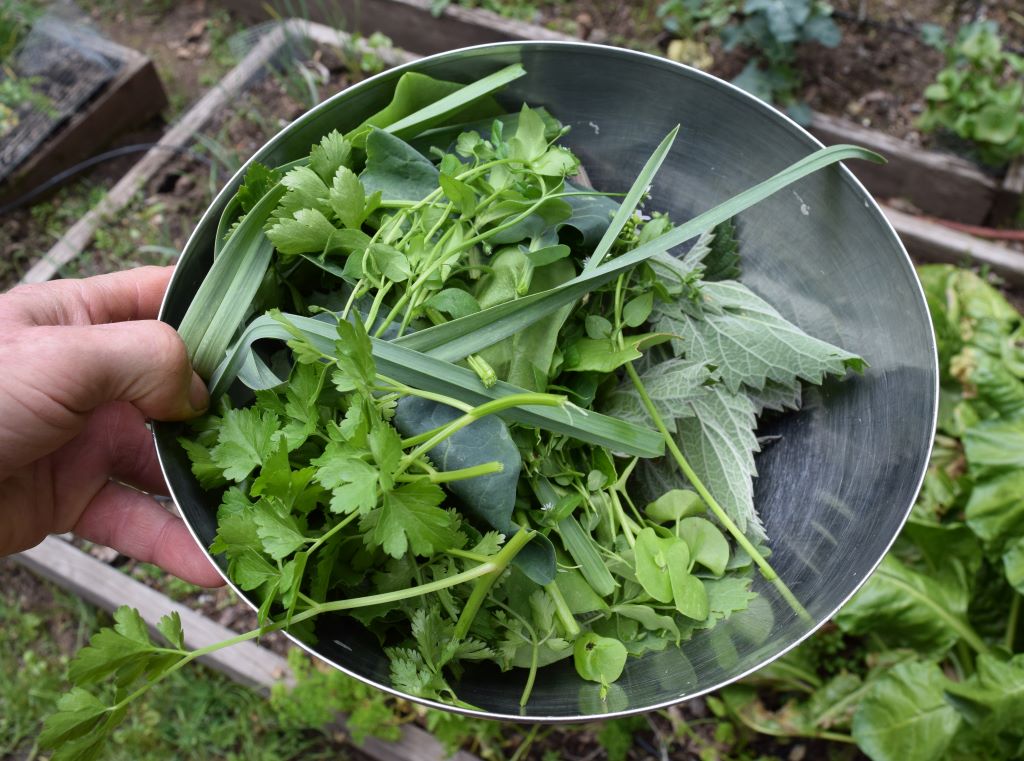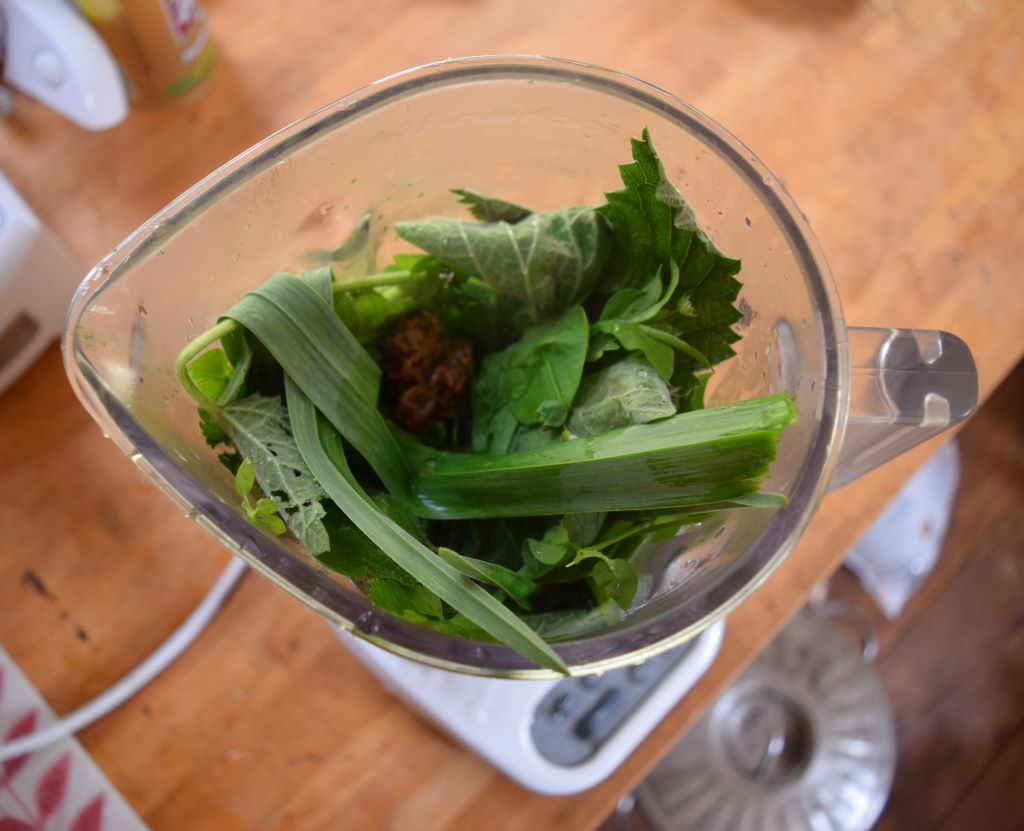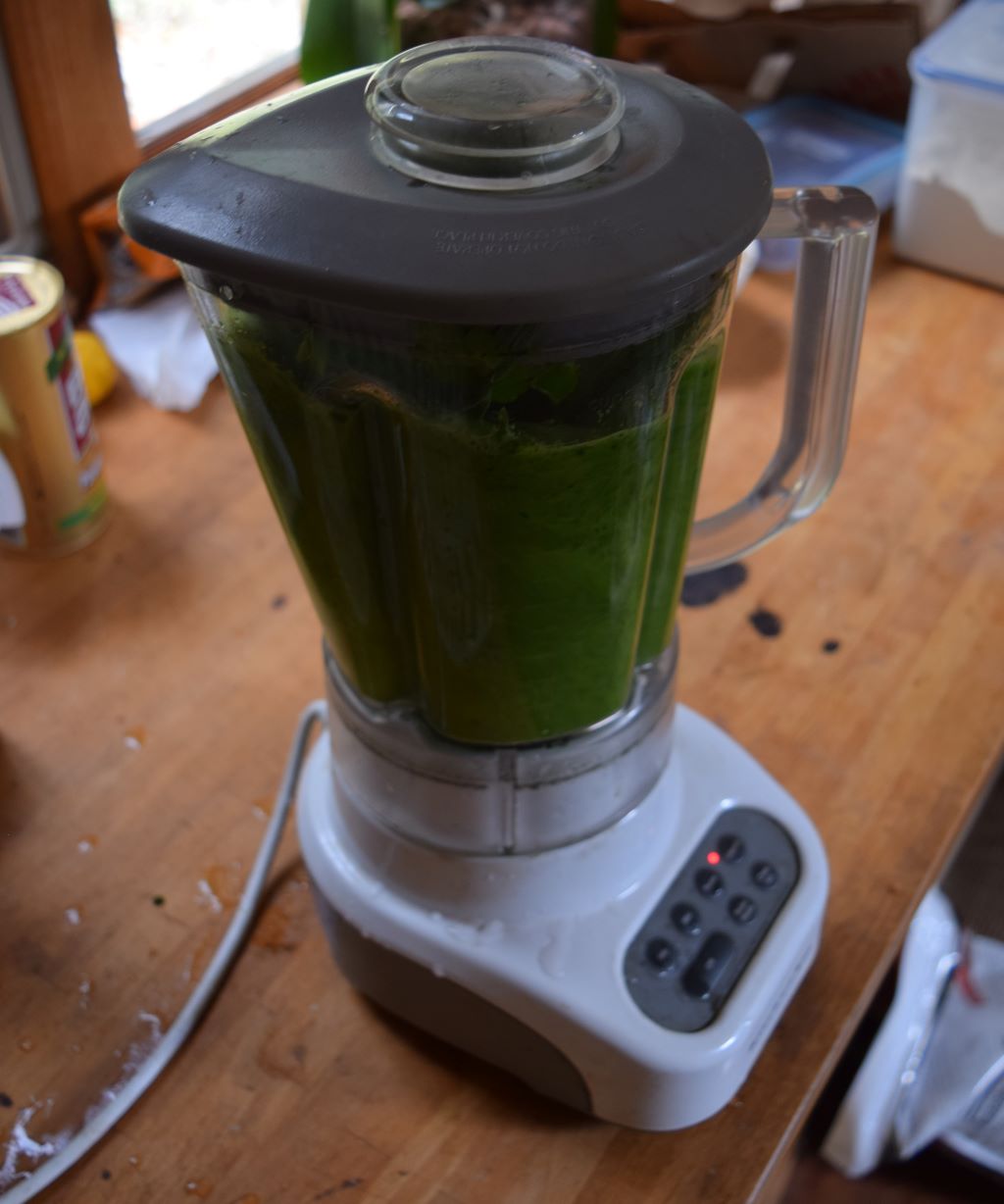Green Drinks
I first read about green blender drinks over 30 years ago in a nondescript little book called Natures Healing Grasses by E. M. Kirschner and have been making them ever since. They are the best way I know of to consume some of the leaves and other things you would like to eat for their undisputed health benefits, but don’t necessarily like very much. They are a simple and free (or inexpensive) way to enhance your health without buying high priced food supplements. They are also superior, as the nutrients are fresher, in easily digestible forms and come with all of their valuable fiber. The green drink can even be a substitute for a meal (it will probably be a lot healthier than the meal you missed).
A carefully made green drink tastes pretty good (or even delicious depending upon what you put in to it). When I first started making them, I was basically making a smoothie, with a base of fruit juice, into which were blended various nutritious green leaves and other food supplements. Recently my friend Nell in Oakland showed me how she has been making a more savory version, using hot water and miso, to make a kind of instant and very green soup. This was a revelation and transformed the way I think about these drinks. Whichever you choose, both are very simple, and once you have the ingredients they only take a few minutes to prepare.
Ingredients
You can use a variety of products from the garden, in fact it is possible to make it entirely from the garden, if you are motivated in that direction and have lots of imagination.
Fruit juice: If you are going for a sweeter green drink, you can use fairly sweet fruit juice (I often get the inexpensive juice cocktails). Fresh juice is nutritionally superior to pasteurized juice, but the latter is more convenient and cheaper. The ideal would be to use fresh juice from the garden, but of course that isn’t always available. You could also use carrot juice if you want to grow everything yourself.

Green leaves: You can use any edible leaf, either wild or from the garden. I just go for a walk and pick what is available (if it’s not from your garden you must clean it thoroughly). If you have to go some distance to gather then you will probably want to pick enough leaves in one go for several drinks, they will keep in the fridge in a plastic bag for several days.
I most commonly use leaves include Amaranth, Comfrey (some people warn against using this plant because it contains toxic pyrrolizidine alkaloids), Chicory (bitter), Chickweed, Dandelion (bitter), Dock, Kale (and other mild Brassicas), Lambs Quarters, Mallows, Miners Lettuce, Storksbill, Violet and Strawberry leaf. I also grow a few leaves especially for these drinks, include Gotu Kola, Echinacea (small amounts only) and Ashwaganda. Some of these leaves contain minor toxins (oxalic acid, saponins, etc) so I prefer to gather a variety of leaves when possible and only a couple of each.
If you are going for a more savory drink, you might add Parsley, Celery, Lovage, Green Onion, Sage and other highly flavored leaves.
Seed sprouts Alfalfa, Clover, Sunflower are all convenient, relatively mild tasting and add a lot of nutrients and fiber. They are particularly useful in winter when there may not be a lot of green leaves available.
Fruit: I often add a banana for its sweetening and thickening properties. I might also add Blueberry, Raspberry, Strawberry, Blackcurrant, Peaches, or whatever is available. I also add some of the miscellaneous berries from around the garden or foraged from the wild, Aronia, Viburnum, Amelanchier, Goji berry, Elderberries, Rose Hips (flesh only) This is a good way to use some of the berries that don’t taste that great but contain special nutrients. You might want to freeze a surplus of berries in the summer for making drinks in the winter.
Sweetener: Using one of these enables you to add more bitter ingredients. A banana works best, but raisins and Stevia can also be used.
Seeds: These add protein and minerals to the drink. Blending them helps to make them more digestible. I most often use Sunflower seeds, but have also used Pumpkin, Sesame, Evening Primrose, Flax and Walnuts.
Savory flavoring: If you are going for a savory soup, you can use miso, buoillion, soy sauce or even onion soup mix.
Other ingredients These may be added for their unique nutritional properties and could include Kelp powder, brewers yeast, bee pollen, lecithin, Spirulina, dried barley greens, vitamin C powder (makes it quite tart) and more.

Preparing the drink
I don’t have a specific recipe for a green drink, because it varies every time according to what’s available. I just cruise around the garden picking a leaf here and there. As the combination of ingredients changes through the year you will always be experimenting to some degree. If you are going for a tasty drink, don’t overwhelm the flavor with too many bitter leaves (obviously this depends upon your palate.)
Making the drink is pretty simple and only takes a few minutes. Basically you just put everything in the blender and puree it until smooth. I start by putting the seeds and/or nuts in the blender with a small amount of hot water or fruit juice, and blend them to a smooth puree. I then add more hot water / fruit juice and the green leaves and blend until smooth. Finally add the Banana and the rest of the ingredients.
Obtaining the plants
If you are going to make green drinks daily, you will need a good supply of weeds, greens, fruits and seeds. Depending upon where you live that may mean a walk around the neighborhood to gather the greens (be careful where you gather in urban areas) or it may mean growing them yourself (or more often a combination of the two). The perennial weeds Dandelion, Dock, Comfrey, Chicory are particularly useful because they keep growing right through the summer. If you have a large vegetable garden then you will already be growing many useful weeds, the trick is to keep them productive. You can also grow plants for their seeds (Sunflower takes some processing, Evening Primrose and Flax are easier). Seed sprouts are a good addition in winter, when other greens may be scarce.
Caution: Whenever you eat anything you face hazards and certainly collecting and eating wild plants is not without its dangers. Foremost of course is picking a poisonous plant by mistake. However even edible wild plants (and cultivated ones) can contain toxins, such as oxalic acid and saponins. If you aren’t prepared to deal with these hazards, then stick to using only cultivated plants (or buy your food supplements).











